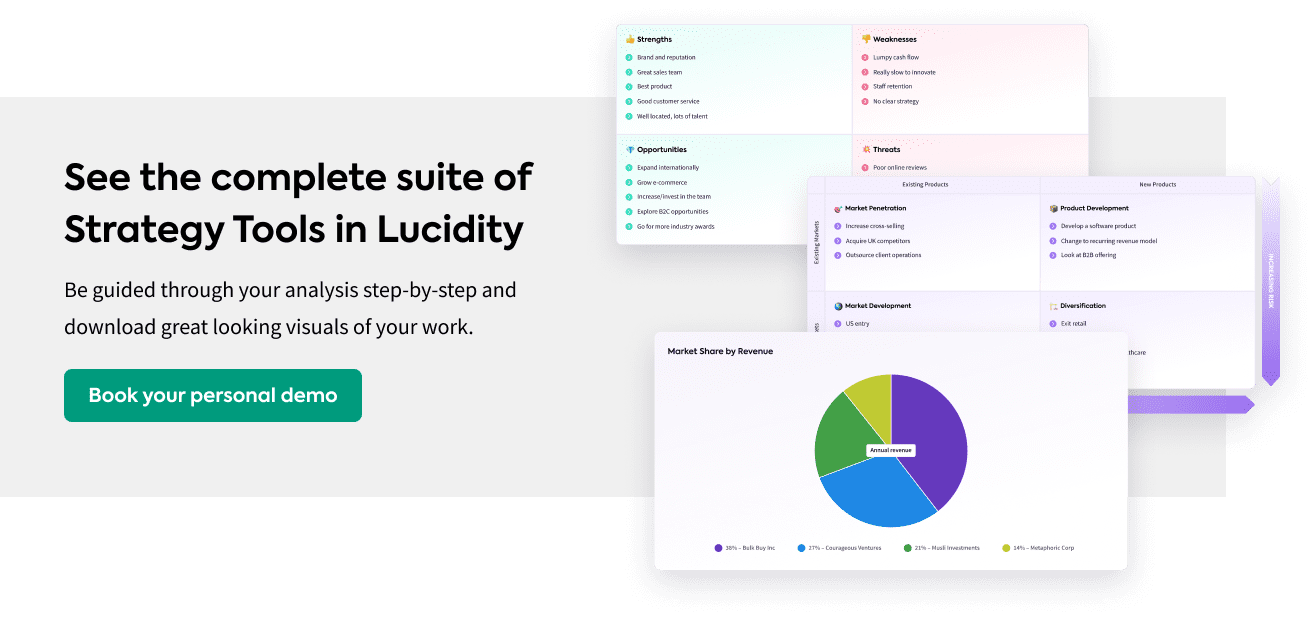In the final part of our series on the best strategy tools to use in your strategic planning, we’re looking at frameworks and models that will help you articulate your strategy, structure your plan and organize your execution.
There are so many strategy tools and frameworks it’s hard to know which do what and when you should use them. With so many options, we’ve set out to bring some clarity and help you quickly and easily know which tools to reach for at each stage of your strategy planning journey.
If you haven’t read the first two parts of this series, in part one we listed out the best strategy tools and frameworks to help you understand your external environment, the market, your competitors and your own business. Then in part two, we went through the top tools to help you understand what your different strategic options are and how to evaluate those and reach decisions about your strategic direction.
So, now, having done that work to understand the best strategy for your business, it’s time to map out that plan and start communicating it through your organization. This is the final stage in the 7 Stages of Strategic Planning that we’ve mapped out previously. Now you know what your strategy should be, you need to get it drawn up, so everyone understands.
Tools for structuring your strategy
Lucidity and the Strategy Tree
Obviously, we’re bias here, but this has to be the cleanest, most intuitive and digestible way to structure and present a strategy. Not only for the purpose of getting your people to understand the plan, but also as the foundations from which you build out the execution activity.
Unlike a lot of strategy structures, our Strategy Tree goes right the way down to the tasks (and checklists) that will ensure goals are hit, objectives are met and visions become a reality.
In Lucidity we’ll help you structure your strategy with a Strategy Tree. Your tree will have one overall Strategic Vision which will then have a number of Strategic Objectives that branch out from it. Each Objective will have a number of goals and/or initiatives linked to it and each of those will have their own list (or board or timeline) of tasks.
Your entire strategic plan – easy to see, simple to understand, with everyone’s tasks clearly linked to the overall strategy so your contribution is obviously to all.
Book a demo and see the Strategy Tree in action
Either start with a tailored template or build and adapt your own version from scratch.
VMOST
This is a slightly different way to lay out your strategy and help align your business activities to the overall strategic ambitions you have. The framework follows the structure of Vision, Mission, Objectives, Strategies and Tactics. We won’t get into the possible confusion here with this definition of strategies (which are a little like ‘initiatives’ in Lucidity) but you can read our full guide if you want to explore this more.
OGSM Framework
OGSM stands for Objective, Goals, Strategies and Measures. In this model, there is one overall Objective which has Goals, Strategies and Measures attached to it. In this framework the Objective is akin to a Vision – one clear statement of the company’s ambitions.
Strategy Maps
These ‘maps’ are focused on just your strategic objectives and groups them under four titles – Financial, Customer, Internal Processes and People & Learning. It’s a tool that’s suited for communicating out summaries of your top line priorities.
Strategy Diamond
The Strategy Diamond can either be used to give a quick summary of an overall strategy, or, as a way to help formulate your plan in the first place. It contains five areas Arenas, Vehicles, Differentiators, Staging and Economic Logic. It helps you map out where the business is active, how you’re planning to progress, how you will stand out, in what order you need to execute the key tasks and the commercial models that will drive profits.
Tools to test and review your strategy
The final stage in any robust and thorough strategic planning process is, once you have a strategy that you’ve mapped out in a clear and consistent way, to review it and test it. Yes, it’s time to really interrogate that proposed strategy and see if it holds water.
So, here are our favourite strategy tools and frameworks to help you road test your strategy and see if it passes. To play devil’s advocate and ask some really probing questions to stress-test your plan and make sure it’s right.
It’s certainly easier to interrogate your plan now, spot weaknesses and make adjustments at this stage, rather than waiting until you’re well into the execution and not getting the results you were expecting.
Mintzberg’s 5 Ps of Strategy
The 5 Ps in this framework each relate to a different angle from which to assess your strategy. The 5 Ps are Planning (have you done enough background research to ground your decisions?), Ploy (have you got a clear competitive strategy and a proper plan to take on the competition?), Pattern (are you taking advantage of unforeseen results or circumstances to drive growth?), Position (do you have a well thought-through ambition for your position in the market?) and Perspective (have you asked your employees, customers and suppliers to understand how the company is perceived?). Check out our Guide to Mintzberg’s 5 Ps for a list of specific questions to ask as you interrogate your strategy with this tool.
Weisbord’s 6 Box Model
The 6 Box Model is a great tool to help you assess the execution of your plan. If you’re not entirely satisfied with how you’re performance is going then this framework is a useful tool to help you uncover the issues in the business that are hampering your execution of the strategy. The framework has six areas – Purpose, Structure, Relationships, Rewards, Leadership and Helpful Mechanisms. By working through each ‘box’ in this model and asking all the related questions for each area, you will uncover specifically where your problems lie. Is it a problem with the way your teams are structured, is it something about the management style, are people not rewarded properly, are your processes inefficient?
Final Thoughts
However you choose to structure and present your strategy plan to the business, it’s crucial that you make it as easy to understand as possible. Take a look at our article on How to Win Buy-in for Your Strategy and you’ll see that one of the key factors for successful execution of any strategy is ensuring everyone in the company understands the plan. For anyone to buy into your strategy, first they need to understand it. So pick whichever strategy tool you think will make your strategy plan simple to understand.
The next crucial thing is to ensure your structured, clearly laid-out strategy plan is easily accessible. Too many businesses spend time and effort producing a thorough strategic plan and then bury it in files and folders. People are busy, if getting to the strategy documentation is arduous people won’t bother. So make sure, once you’ve got your plan nicely presented, that you put it somewhere everyone can get to easily.
And finally, make sure your strategy documentation is always up-to-date. If you want your people to be motivated and engaged with the plan, then you need to bring it to life. You need to show progress, surface milestones and results, present a living, breathing plan. Do not take your chosen strategy framework and create a few PowerPoint slides that are only updated for your quarterly town hall meeting. Make sure that whenever anyone on the team looks at the plan, it’s up-to-date and shows your progress.
We believe strongly in each of these points, and that’s why we created Lucidity. We’ve been able to transform how businesses plan their strategy, get their people engaged and manage the execution. All by making strategy easy to understand, presenting it clearly, putting it in one central, easily accessible place and making it dynamic, up-to-date and easy to track. We’d love to show you how it all works if you think that would work well for your business.
Good luck presenting your plan and testing your strategy!
See how easy it is to structure your strategy and bring it to life in Lucidity
Book your personal demo and we’ll show you how to build a plan and make it happen, the easy way.












